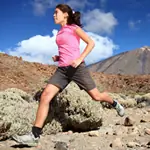
As soon as Cynthia Ferrer took up trail running, at 50 years old, she was hooked. There was just one problem: The energy used to balance on loose terrain and maneuver over rocks and around trees left her muscles sore and tired. "Everything from my tailbone to my hamstrings hurt," she says. "And I was a lot tighter." To mitigate the pain, Ferrer began chasing her runs with 15-minute ice baths and took to massaging herself with foam rollers. "Doing those things allows me to recover much faster," she says. "With that program, I can run five or six days a week, covering 26 to 32 miles over that time."
More: How to Ice for Optimal Recovery
Icing and massage are just two ways runners can help themselves bounce back from tough runs and ensure they're ready to hit the trail again the next day. Here, Josh Shadle, the owner of AllSports Recovery Club in Boulder, Colorado, demonstrates the best stretches and products to ease post-run soreness, while Stacy Sims, a Stanford University exercise physiologist and nutrition scientist, provides advice on what to eat after a run. Keep in mind, this isn't a hard and fast program. Adding even a few of these recovery steps, Shadle says, "will help you feel much better the next day." To seriously avoid getting hurt after runs, follow these 10 rules for injury prevention while on the run.
More: 9 Running Injury Prevention Tips
1. Compress Yourself
After a workout, metabolic waste begins to pool in your feet and legs, causing swelling and soreness. Squeeze the harmful fluids from your extremities by throwing on compression socks from CEP ($60; cepcompression.com) and some Blade-Light Recover shoes from K-Swiss (from $75; kswiss.com) directly after a grueling run.
2. Be Kneady
To take an active approach to removing metabolic waste, invest in a Tiger Tail massage stick (from $30; tigertailusa.com) and a large round foam roller (from $8; nefitco.com), or just use a tennis ball. Spend five minutes massaging the muscles in your legs, focusing most on areas that feel tightest (For a complete video of moves that ease soreness, watch DIY Total-Body Massage). Then lie directly on the foam roller or tennis ball, moving in small circles to break up tight muscle fibers. "That stimulation also causes oxygen-rich blood to flow to those areas," says Shadle, "which will help damaged tissue heal faster." For even more stimulation, Shadle recommends adding vibration to the mix.
A recent study published by the School of Exercise and Health Sciences at Edith Cowan University in Australia showed that using a device which delivered vibration to muscles postworkout helped lessen the duration of soreness. Plenty of companies sell vibrating massagers for upward of $100, but Shadle says that's a waste of money. Instead, he recommends going to The Home Depot and buying a Ryobi six-inch car buffer for $25. "It does the same thing that any of those expensive products do." (Be sure to keep the buffer away from your head and hair.)
More: What Causes Delayed Onset Muscle Soreness?
3. Step It Up
Trail runners work every muscle in their legs, but with undulating terrain and uneven footfalls, the vastus medialis obliquus (VMO) take the most severe beating. Located on the inside of your lower thighs, the VMOs are the muscles that prevent your knee from buckling inward. And if you've ever done a really hard, long trail run, they're probably the first muscles to cramp. To flush metabolic waste from the VMOs, as well as your other muscles, Shadle says to hop on a stepping machine for 10 or 15 minutes and work at a medium to slow pace. "It utilizes the same muscles as running without putting a lot of strain on ligaments, which need rest." And the up down movement creates a pumping action that more quickly extracts harmful fluids from the muscles. If you don't have access to a stepper, Shadle says, biking slowly or even jogging also works, as does laterally hopping from one foot to the next for 30 seconds at a pop.
- 1
- of
- 2
Get ACTIVE on the Go


Couch to 5K®
The best way to get new runners off the couch and across the finish line of their first 5K.
Available for iOS | Android







Discuss This Article